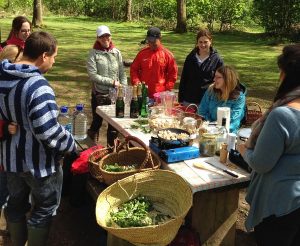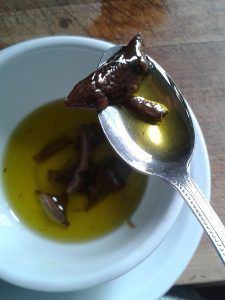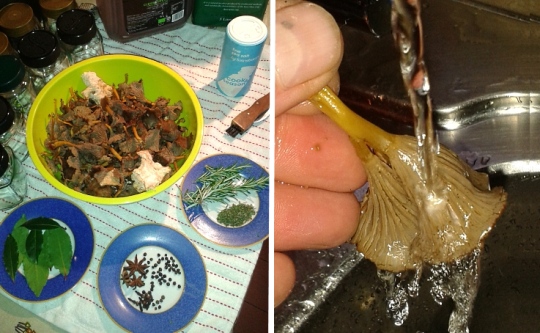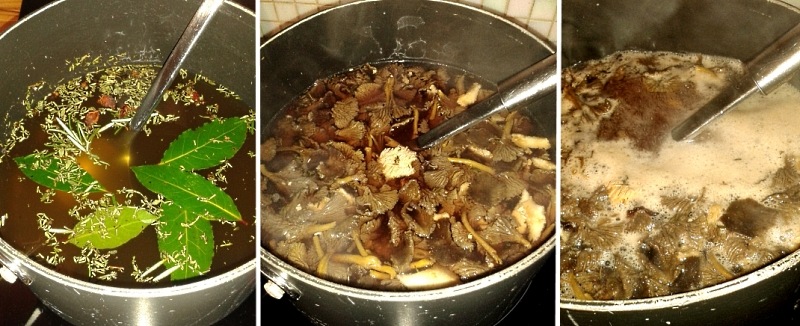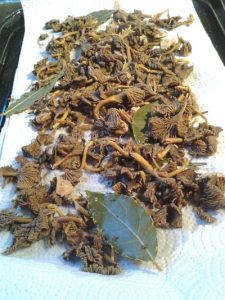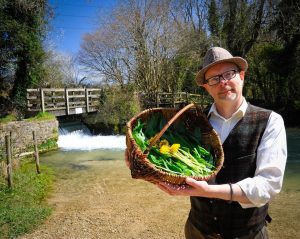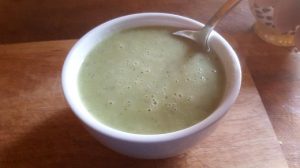 I have been taking people out to forage for spring cures for many years, and I look forward very much to making my own spring cure at this time. It is not essential to use all seven herbs, and substitutions can easily be made, but be sure to stick to stinging nettles for the base.
I have been taking people out to forage for spring cures for many years, and I look forward very much to making my own spring cure at this time. It is not essential to use all seven herbs, and substitutions can easily be made, but be sure to stick to stinging nettles for the base.
Young spring greens of various kinds are high in vitamin C and a range of minerals (including calcium, iron, magnesium, potassium, etc.), as well as being jam-packed with antioxidant bioflavonoids that help to mop up free radicals, preventing and limiting oxidative stress damage in the body.
These bioflavonoids help your cells to bounce back to their full fighting-fit metabolic health after dealing with the challenges of poor nutrition and a sedentary lifestyle. They may even assist the body to heal from viral infections and to deal with other difficult challenges; perhaps even chemotherapy and radiotherapy.
After a long winter with a lack of fresh green vegetable matter on the plate (remember – there were no supermarkets and no mass import of vegetables into the UK until the present era), the spring cure would have been consumed in the form of a delicious soup, daily, for at least a week or two, to help bring the body back into condition, restoring vitality and sparkle to skin, hair and eyes. It would have also helped more serious conditions like scurvy, which is caused by chronic vitamin C
deficiency. These herbs have a reputation for assisting elimination of toxins by giving a boost to the liver, kidneys and lymphatic system, and nettles and cleavers in particular provide bio-available silica for healthy connective tissue and joints. Note that in general, the proportions should be 80% young nettle tops to 20% of all of the other ingredients found below combined (or whichever ones you can get a hold of in your area). It is also worthy of note, that if you are using wild garlic, you might want to tweak that ratio to increase the proportion of wild garlic leaves, as they are simply delicious!
A note on selecting and sorting the ingredients:
Use only the young, tender, above ground parts of the 7 herbs below for this recipe. Where the stem is fibrous, be sure to perform the ‘turgidity test’ – so if it is still flexible and bendable then it is also tender enough to go in the pot. The stiffer parts of stems won’t bend in a nice curve when you apply sideways pressure, and they should not be used for this recipe as they will impart a fibrous texture that is not in keeping with the desirable creamy nature of the soup… and in larger amounts might even cause bloating and flatulence for those with sensitive digestion. The young tender green parts that you will use contain plenty enough insoluble fibre without adding lots more by putting in too many tough stems.
Method: This delicious recipe could not be simpler to create!
- First wash and then chop the herbs, discarding any tough stems or damaged leaves, and set them to one side.
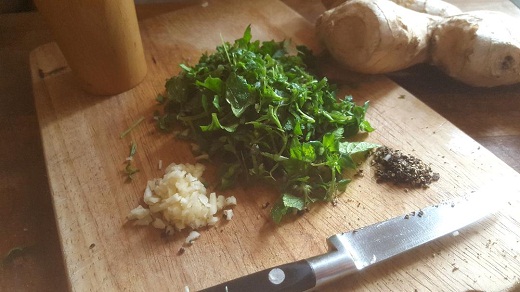
- Select a saucepan with a lid, and add a decent sized knob of butter or two tablespoons of olive oil to the pan.
- Also add salt and pepper, according to your taste.
- If you are not using wild garlic among your herbs, consider adding some grated garden garlic or diced shallots. A little grated ginger can be a nice addition too.
- Add two tablespoons of water to the pan.
- Add the chopped herbs to the pan until it is almost full to the top. Put on the lid and bring up to medium heat, slowly, over 3 or 4 minutes. Allow to simmer rather than boil.
- After about 11 or 12 minutes, the contents of the pan should have reduced to about one-third of their original volume. Take the pan off of the heat and allow to cool for 5 minutes.
- Use a stick blender if you have one, or transfer the contents to a food processor, and ‘give it a whizz’ to make the soup nice and creamy. If you like a thicker soup, you can also boil a few new potatoes to add at this stage.
- Serve the soup in bowls, swirling in a little cream, crème fraiche or natural yoghurt, and garnishing with a few leaves of coriander, ground ivy, or even herb Robert, Geranium robertianum, also known as ‘Stinky Bob’!
Stinging nettle
Urtica dioica
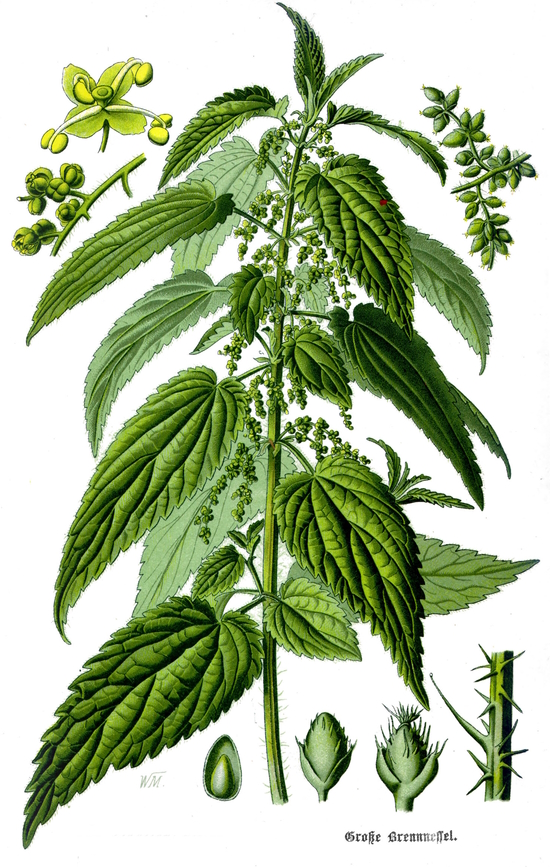
FEATURES:
Calcium, iron, silica, vitamin C, and in addition, plenty of anthocyanin / procyanidin flavonoids, which are good for heart health and mitochondrial health, as well as promoting healthy skin and healthy hair. Stinging nettle has many other medicinal properties and contains lots of medicinal compounds, but these are the chief ones that we will be making use of in our nettle soup-base, which must not be overcooked or zealously overheated to gain the maximum benefit from them.
PICKING NOTES:
Stinging nettles are very common in the UK. The stinging hairs are little hollow silicate needles and each one is attached to a bag of venom, that contains formic acid (ouch), and neurotransmitters such as serotonin, dopamine and acetyl choline (that cause a creeping sensation in the skin). These are largely going to be destroyed by our cooking process. The finished soup will have no sting at all, I promise!
To pick nettles without being stung, the secret is for the hand to be already moving upwards as it grasps the nettle firmly. This is because all of the stinging hairs are capable of hinging upwards towards the tip of the plant, and so they fold over when the nettle is picked in this way. Rubbing your hand against the direction that the hairs fold in, i.e. running it down the stem, will result in being severely stung! You could always wear gloves.
If you do decide to pick nettles to use the leaves later in the year, then it is a good idea to cut them down to ground level first, and wait two weeks before harvesting. Mature nettles are not as tasty and they also produce small but insoluble, sharp, crystalline growths at a microscopic level that just might be an irritant to your kidneys or GI tract. The nettle seed and root does have other, completely different uses, but we will save these for another article at a later date!
Ramsons / wild garlic
Allium ursinum
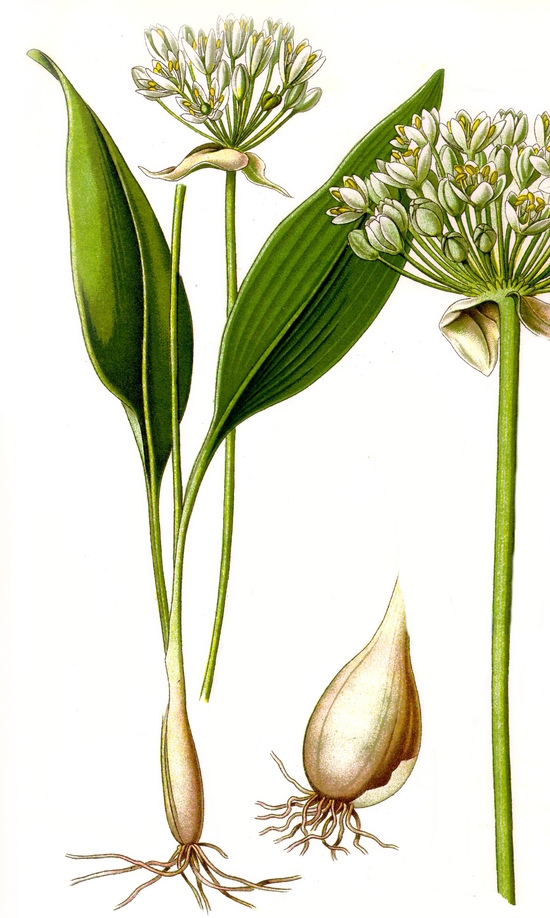
Note that this is correctly called ‘ramsons’, and not ‘ransoms’. In the US, the similar ‘ramps’, Allium tricoccum, can be substituted.
FEATURES: .
All parts are edible but the bulbs of A. ursinum are disappointing and best left to grow another plant next year. As well as the leaves, stems and flowers being delicious, ramsons, like garden garlic, has a broad spectrum antibiotic action, particularly exerting its influence on the respiratory tract, and by dilating the capillary blood vessels of the circulatory system, it directs increased blood flow to the skin. The quantities used in this recipe are not written in stone, so be prepared to experiment by adding extra ramsons to get the taste right just for you, especially if you adore garlic!
PICKING NOTES:
Be VERY CAREFUL when gathering ramsons in Europe, not to gather the young leaves of Lords & Ladies, Arum maculatum. Take a note of the differences before you go foraging for them:
Fully grown Lords & Ladies leaves have a fork at the base of the leaf, and they are more or less arrow-shaped, unlike wild garlic. Mistakes tend to happen when it is very young ramsons being picked, because the young leaves or Lords & Ladies are NOT forked at the base, giving them a very strong resemblance to young ramsons! If in doubt, flip them over… ramsons leaves have parallel veins on the underside, but Lords & Ladies has a system of branching veins. Knowing that, one can generally forage for ramsons confidently, providing that one pays attention.
In the areas where it grows, wild garlic appears to be super-abundant, forming large swathes and carpeting broad-leaved woodland. It is fairly delicate however, so please try not to trample it. Possibly the ideal way to pick it is to pick a circular area about the size of a football. You will notice lots of much smaller leaves underneath, emerging from the ground, and these will soon grow to close the gap you have created. Doing it this way, means that you will avoid excessive trampling of the plants. Try to never pick more than 3 leaves at a time. This will make it easier for you to keep an eye out for young Lords & Ladies and stop it finding its way into the batch.
Cleavers / Goosegrass / Sticky Willie
Galium aparine
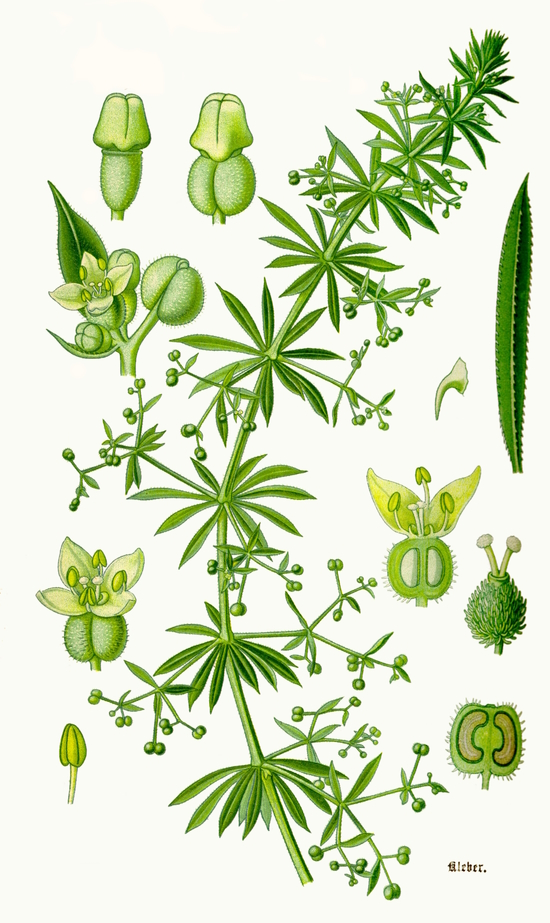 FEATURES: .
FEATURES: .
This little member of the coffee bean family should be familiar to everyone. The little round seeds – from which a palateable and caffeine rich coffee can be made later in the summer – will get stuck all through your dog’s fur and your clothing too! The whole plant is covered in little hooked hairs, and for this reason it should not be consumed raw, as these can cause skin rashes in susceptible people, and can lead to a sore throat too!
The structure is said to resemble the branches and nodes of the lymphatic system, and cleavers is recognised as a good lymphatic tonic, for ‘clearing the lymph’, as was once said.
Little parcels of still-tender tips can be lightly steamed and served with butter, but like nettle it lends minerals, including silica, to our spring cure soup, as well as copious amounts of vitamin C, and with its’ lymphatic properties too… what a star!
PICKING NOTES:
You will normally find this species just about everywhere that you look for it, from early spring onwards. Be sure that it sticks to your clothing, otherwise you may have one of the other bedstraws, or Galiums… possibly even sweet woodruff!
Ground elder
Aegopodium podagraria
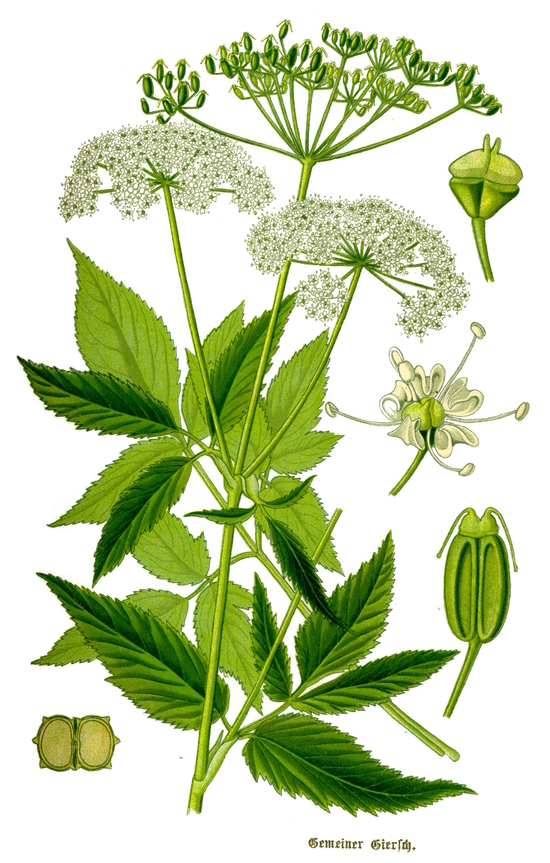 FEATURES: .
FEATURES: .
Ground elder is one of the easiest members of the carrot family to identify, but you still need to make sure that you learn it properly before you go about eating any, as this family not only contains culinary essentials such as the carrot, parsnip and celery, and the herbs fennel, chervil and dill, but it also contains some of the most poisonous plants known to humankind, such as hemlock and hemlock water-dropwort.
That said, it is a fairly easy vegetable to recognise, in part due to its’ elder like composite leaf shape. The whole herb has a taste somewhat reminiscent of a cross between anise and celery, when fresh. It is a good salad herb, with a pungent flavour that becomes much milder once it has been cooked.
Tradition states that ground elder was bought to Britain by the invading Roman army, around 2000 years ago. Presumably, with the business of an invasion going on, troops had to be fed and you would not want to grow plants that needed a lot of laborious tending to get results. Ground elder needs anything but. It is the bane of gardeners everywhere, propagating itself mainly via underground runners, but given a free rein over some otherwise neglected area, it can make attractive ground cover and a tasty crop. I also love it in salads.
Ground elder, like celery, has a reputation for being a bit of a diuretic and helping the kidneys with their job of elimination. Along with nettle and dandelion, it should be helpful where there are small kidney or bladder stones, and it should also help to chase away an attack of gout!
PICKING NOTES:
You shouldn’t have any trouble finding some ground elder to pick, but if in doubt, always ask an expert for their opinion. If you are brave enough to grow it in your garden, then give it a small island border all to itself, and contain it by mowing round it, or better still, grow it in a big tub. If you don’t wat ground elder popping up everywhere, then do not let it flower!
Dandelion
Taraxacum officinale
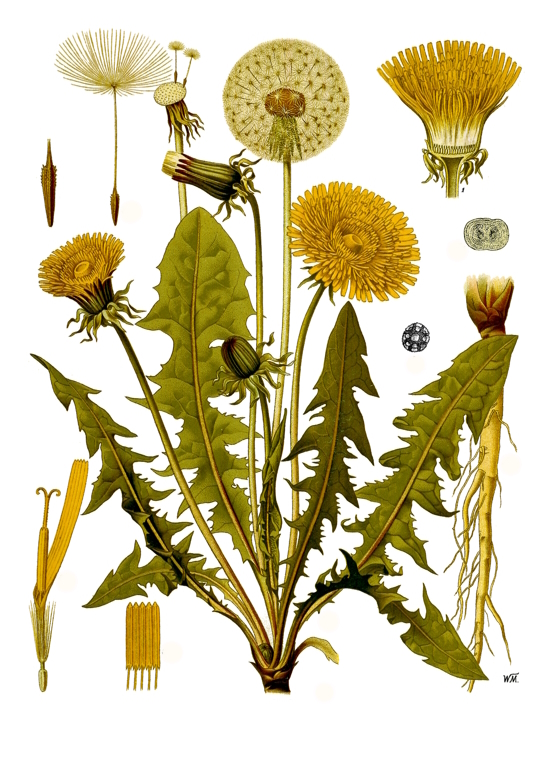
FEATURES: .
Like most of the plants in this series, this one is very common and probably needs no introduction to most everyone! It is a wonderful early season nectar source for pollinating insects such as bees and small beetles, yet you may be surprised to learn that dandelion seldom reproduces sexually over much of its range. It is a species complex comprised of many stable species, and these usually reproduce by parthenogenesis – something that has bee called ‘virgin birth’, where the female ovum just clones itself, meaning that all new seed are identical clones of the female mother plant. Apparently there are some exceptions to this rule too… in parts of south America and Spain.
Like cleavers, dandelion root can be dark roasted to make an excellent ‘coffee’, but it is the leaves and maybe a few flowers that we are interested in here, for our Spring Cure Soup. Dandelion is another ‘herb of elimination’ that benefits the kidneys and the urinary tract, supporting them in their action of cleaning the blood.
PICKING NOTES: .
If you intend to weed dandelion out of a garden or allotment, then this provides an ideal opportunity to pick the leaves and harvest the roots for use in making coffee, as a roasted vegetable, or as a medicine. Any small section of root that gets left behind in the soil will grow back. In practice this will happen often!
Dandelion can be found all year round but it is at its prime in the spring. For salad use – very popular in Belgium and France – the leaves are first blanched for a week under a terra-cotta bell, making them sweeter and more palatable. For our soup, a few wild harvested leaves will be fine. The bitterness of dandelion stimulates the vagus nerve and in turn this results in bile secretion, an increase in digestive enzyme production and an increase in peristalsis, meaning that dandelion is not only a good kidney herb, but it is also a good tonic for a sluggish digestion and could improve nutritional absorption too!
Red deadnettle / Purple archangel
Lamium purpureum
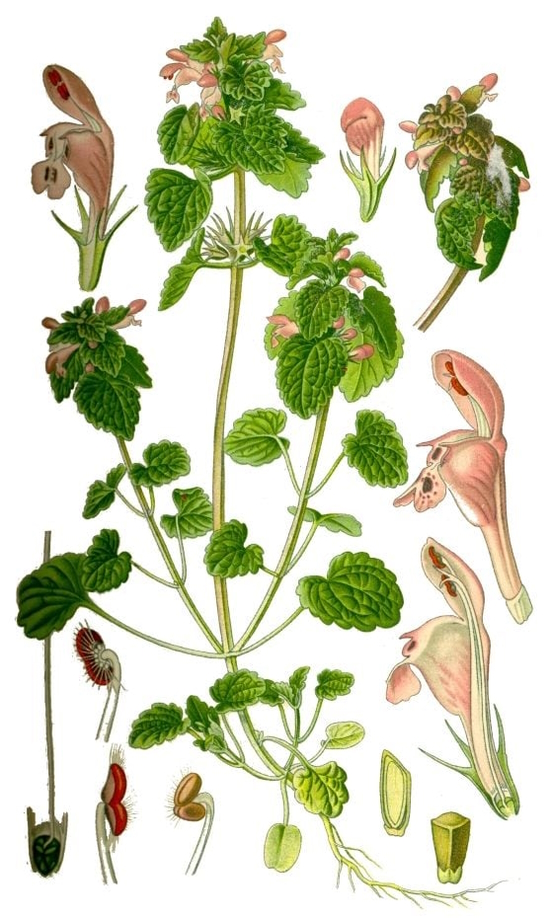
FEATURES:
Like other members of the mint family, this plant has square stems, and bears flowers in the leaf axils that are tubular and have a prominent lower lip. This lip feature gave the mint family its former name of Labiateae. Though it doubtless has many other uses, it is included here for flavour and texture predominantly. Like all of the plants in this section, it is rich in vitamin C and a range of minerals.
PICKING NOTES:
Very, very common and often considered to be a weed species in gardens and allotments, yet the young tops are actually quite tasty and can add interesting texture and flavour to mixed salads.
Ground ivy
Glechoma hederacea
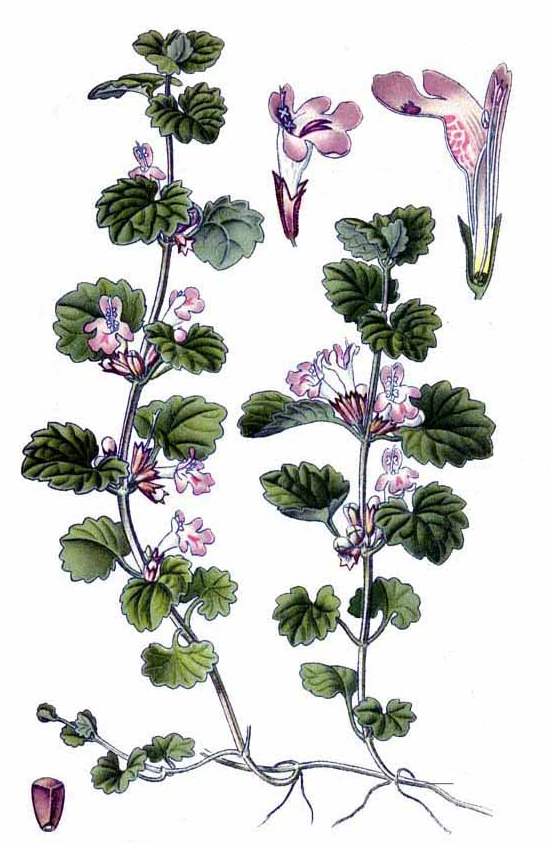
FEATURES:
Ground ivy is a prostrate creeping herb in the mint family. It is not even distantly related to its namesake, the ivy, which should not be used. With an obvious square stem and tubular, prominently lipped flowers that are born in the leaf axils, as well as leaves borne in opposite pairs, this is an obvious candidate for the mint family. Every now and again it throws up erect stems on which to bear its pretty lilac to blue flowers.
Once upon a time, this was a flavouring for ale, before hops became popular in Britain, and that lends to it another country name, which is ale-hoof. The flavour is somewhat like its distant cousin in the mint family, the sage. In mediaeval cookery, ground ivy was finely diced and made into a “mint-sauce” style sauce using vinegar, to be served with red meat and game.
Ground ivy has a unique ability to dry up mucus secretions in the sinuses, and for this reason it makes an excellent herb tea to enjoy in hayfever season, particularly if you are sensitive to oilseed rape / canola flowers. At a push, even eating a small handful raw will often bring considerable relief! Although it is doubtless full of vitamins and minerals, it is included in this recipe predominantly as a flavouring herb – imparting a herby flavour to the soup.
PICKING NOTES:
Like all of the herbs used in this recipe, ground ivy is very very common, and found just about everywhere! Shady spots can often produce the lushest of plants, and I always feel that it is an added bonus to add a few that are in flower.
Other plants that could easily be added or substituted for the above (except for the stinging nettles – retain those):
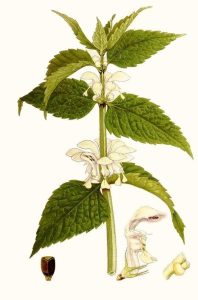
White deadnettle, Lamium album
- Chickweed, Stellaria media
- Greater plantain, Plantago major
- Ribwort plantain, Plantago lanceolata
- White deadnettle, Lamium album
- Wall pennywort, Umbilicus rupestris
- Spring beauty, Claytonia perfoliata
- Sea purslane, Atriplex portulacoides
- Sweet violet leaves, Viola odorata
- Three-cornered leek, Allium triquetrum
- Crow garlic, Allium vineale
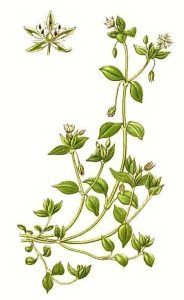
Chickweed, Stellaria media
If you found this interesting, then The Wild Side of Life runs a series of foraging courses in the spring and summer, and a Spring & Summer Forager’s Club, both of which have healthy eating as medicinal herbs as their focus. The Yellow Emperor, from Han Dynasty China, the classical Greek Hippocrates, and the Persian scholar Avicenna, were all credited with the important philosophical tenet “Let food be thy medicine”. On our courses, we explore how to make that a reality in our daily lives.
During August we also run our Summer Herb School, and our 2 day Herbal First Aid course will be exploring how to wildcraft the healing virtues of these herbs and others in greater depth!
IMPORTANT: Never eat any plant or wild mushroom without being 100% certain of its identification… ok, I know you all know that already 😉
The Wild Side of Life was voted Best Food Foraging Education Provider in the Food & Drink Awards and features in BBC Countryfile Magazine’s ‘Best UK Foraging Courses’. Fred Gillam (also known as ‘Fred the Forager’) has appeared on national television foraging for porcini with Gino D’Acampo, in For the Love of Britain presented by Dame Julie Walters, on BBC radio 2 with Jeremy Vine and on Radio 4’s Farming Today programme. He is the author of Poisonous Plants in Great Britain.

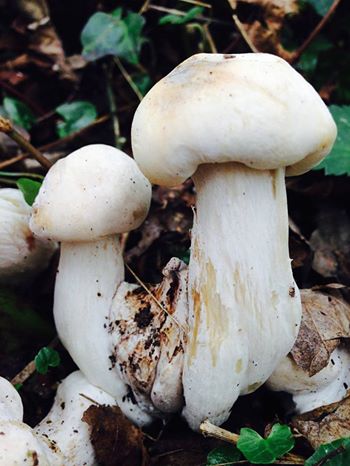
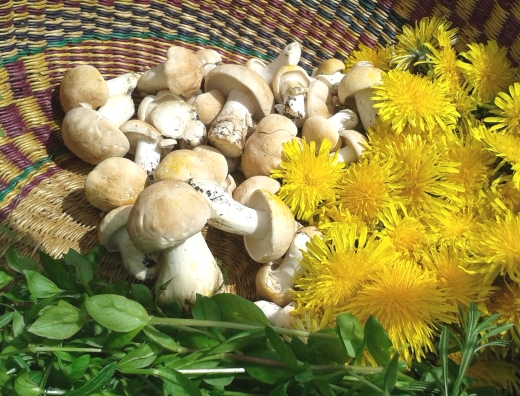
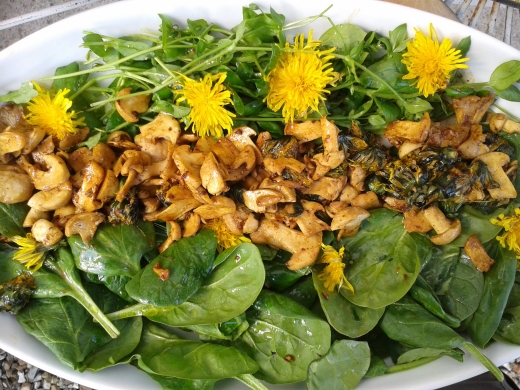
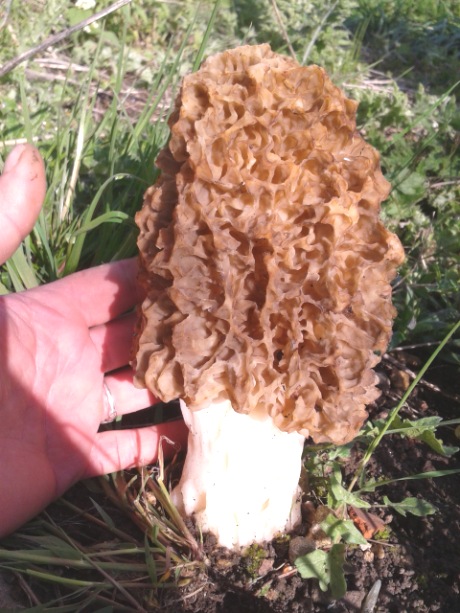

 I have been taking people out to forage for spring cures for many years, and I look forward very much to making my own spring cure at this time. It is not essential to use all seven herbs, and substitutions can easily be made, but be sure to stick to stinging nettles for the base.
I have been taking people out to forage for spring cures for many years, and I look forward very much to making my own spring cure at this time. It is not essential to use all seven herbs, and substitutions can easily be made, but be sure to stick to stinging nettles for the base.


 FEATURES: .
FEATURES: . FEATURES: .
FEATURES: .




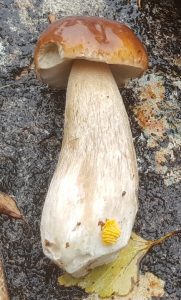
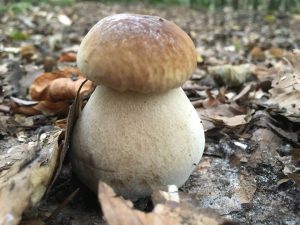 CAP: Yellowish brown to reddish brown… but predominantly brown, looking just like a bread bun on a short, swollen fat stick – hence the name ‘penny bun’. Often there is a paler margin around the edge.
CAP: Yellowish brown to reddish brown… but predominantly brown, looking just like a bread bun on a short, swollen fat stick – hence the name ‘penny bun’. Often there is a paler margin around the edge. 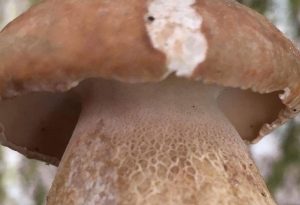 STEM: The stem of the cep can be very very fat indeed, often with more usable flesh in it than the cap itself! The upper stem surface is covered in a very fine, pale/white, raised fishing-net pattern or ‘reticulum’. This white fishing reticulum is a distinctive feature.
STEM: The stem of the cep can be very very fat indeed, often with more usable flesh in it than the cap itself! The upper stem surface is covered in a very fine, pale/white, raised fishing-net pattern or ‘reticulum’. This white fishing reticulum is a distinctive feature.
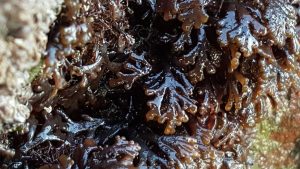
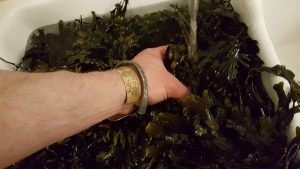
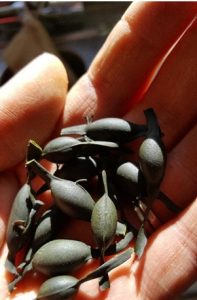
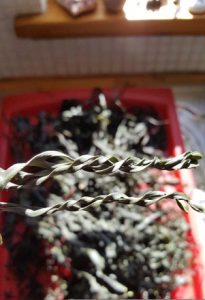
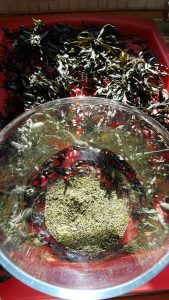
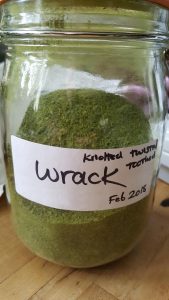
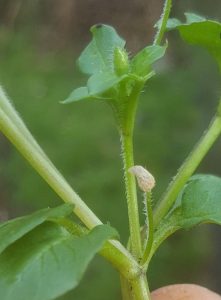
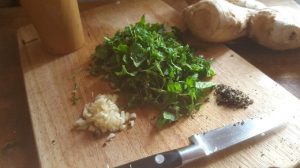
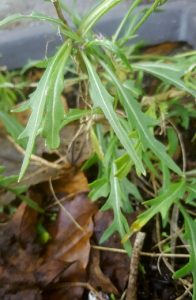
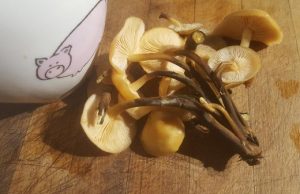
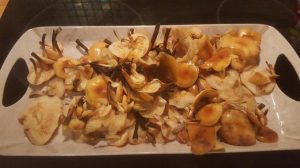

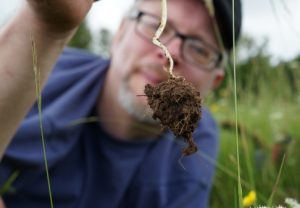
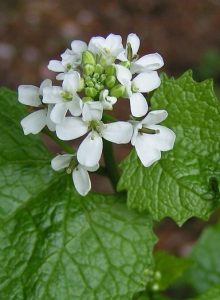
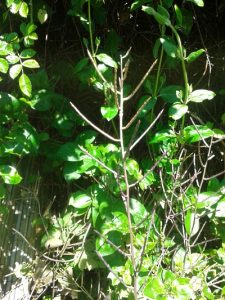
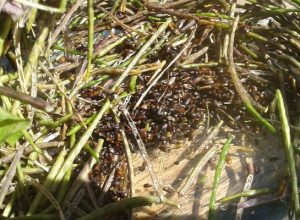
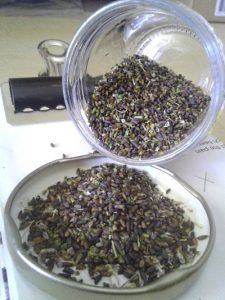
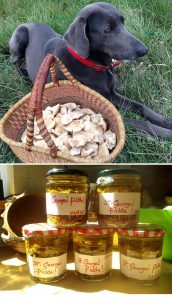
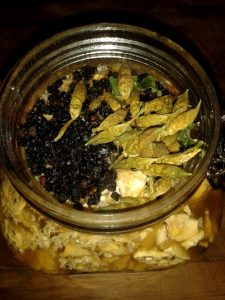 Place the mushrooms, elderberries, ginger, wild garlic buds and black pepper in a large Kilner jar or other similar storage jar. Mix together the warm water, cider vinegar and sea salt until the sea salt is completely dissolved. Pour this liquid brine over the solid ingredients in the storage jar, stir with a wooden spoon and allow the whole to marinade in a warm place for 2 hours.
Place the mushrooms, elderberries, ginger, wild garlic buds and black pepper in a large Kilner jar or other similar storage jar. Mix together the warm water, cider vinegar and sea salt until the sea salt is completely dissolved. Pour this liquid brine over the solid ingredients in the storage jar, stir with a wooden spoon and allow the whole to marinade in a warm place for 2 hours.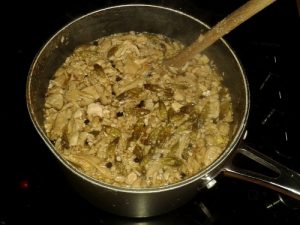
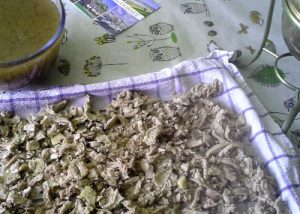
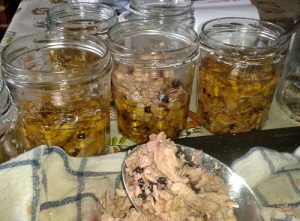
 Always remember to label your produce carefully. Everyone must have found an unlabelled jar at the back of the cupboard at some point – with unknown contents that are probably well past their best. Always put the date of manufacture on the label.
Always remember to label your produce carefully. Everyone must have found an unlabelled jar at the back of the cupboard at some point – with unknown contents that are probably well past their best. Always put the date of manufacture on the label.